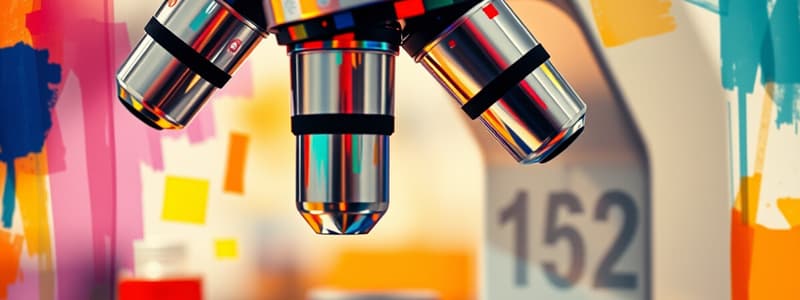Podcast
Questions and Answers
What is the lens the viewer looks through to see the specimen?
What is the lens the viewer looks through to see the specimen?
- Eye piece (correct)
- Arm
- Body tube
- Nose piece
What part of the microscope connects the eyepiece to the objective lenses?
What part of the microscope connects the eyepiece to the objective lenses?
Body tube (head)
What connects the body tube to the base of the microscope?
What connects the body tube to the base of the microscope?
Arm
What part brings the specimen into general focus?
What part brings the specimen into general focus?
What fine tunes the focus and increases the detail of the specimen?
What fine tunes the focus and increases the detail of the specimen?
What houses the objective lenses and can be rotated?
What houses the objective lenses and can be rotated?
What lenses are closest to the specimen?
What lenses are closest to the specimen?
What is the specimen in a microscope?
What is the specimen in a microscope?
What is the flat platform where the slide is placed?
What is the flat platform where the slide is placed?
What switch on the base of the microscope turns the illuminator off and on?
What switch on the base of the microscope turns the illuminator off and on?
What is the light source for a microscope?
What is the light source for a microscope?
What adjusts the amount of light that reaches the specimen?
What adjusts the amount of light that reaches the specimen?
What gathers and focuses light from the illuminator onto the specimen?
What gathers and focuses light from the illuminator onto the specimen?
What supports the microscope and houses the illuminator?
What supports the microscope and houses the illuminator?
Flashcards are hidden until you start studying
Study Notes
Parts of a Compound Light Microscope
- The eyepiece allows the viewer to see the specimen, typically equipped with a 10X or 15X power lens.
- The body tube connects the eyepiece to the objective lenses, providing a path for light to travel.
- The arm connects the body tube to the base, offering structural support to the microscope.
Focusing Mechanisms
- Course adjustment is used for bringing the specimen into general focus, allowing for quick adjustments.
- Fine adjustment sharpens the focus and enhances detail, providing precise clarity to the viewed specimen.
Lens System
- The nosepiece is a rotating turret that holds multiple objective lenses, enabling the user to switch between them for different magnifications.
- Objective lenses are critical components, positioned closest to the specimen, responsible for initial magnification.
Specimen Presentation
- A specimen refers to the object being examined, often mounted on a thin glass slide for viewing.
- The stage serves as the flat platform where slides are placed, facilitating the examination of specimens.
Light and Illumination
- The on/off switch located on the base controls the illuminator, managing the light source.
- Illumination provides light for viewing specimens; modern microscopes primarily use low-voltage bulbs instead of mirrors.
- The iris diaphragm adjusts the light intensity reaching the specimen, allowing for better contrast and detail.
- A condenser focuses light from the illuminator onto the specimen, enhancing the clarity of the image viewed.
Support Structure
- The base serves as the foundation of the microscope, supporting all components and housing the illuminator.
Studying That Suits You
Use AI to generate personalized quizzes and flashcards to suit your learning preferences.




